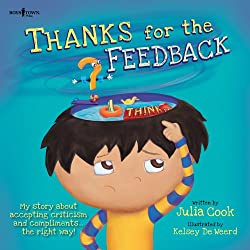SEL Read Aloud: Thanks for the Feedback… I Think? by Julia Cook

Summary
In “Thanks for the Feedback… I Think?” by Julia Cook, RJ struggles with receiving and interpreting feedback from others, including compliments, advice, and occasionally even unfriendly comments. His journey begins with him questioning how to respond, as his reactions vary from self-doubt to defensive. Through various interactions—with his sister, a classmate named Norma, his soccer friend Sam, and his teacher—RJ realizes he struggles to accept both positive feedback and constructive criticism. His parents help him understand the value of feedback, emphasizing that it’s meant to help him grow, even if it doesn’t always feel good. They teach him simple but powerful responses like “thank you” for compliments and “okay” for advice, highlighting the importance of listening and considering feedback without internal turmoil. RJ applies these lessons, improving his soccer skills with Sam’s advice and learning to handle harsh comments from a peer with grace.
Comprehension Questions
Six questions aligned to Bloom’s taxonomy for teacher’s to evaluate students’ comprehension
- Remembering: What was RJ’s reaction when he received compliments from his teacher?
- Understanding: Can you explain what RJ’s parents taught him about how to respond to compliments and feedback?
- Applying: What would be an appropriate response for RJ if another peer gave him unkind feedback again?
- Analyzing: What are the consequences of RJ not knowing how to handle feedback properly at the beginning of the story?
- Evaluating: Critique the way RJ handled the feedback from Bernice at the end of the story. Could he have done anything better?
- Creating: Design a new scenario where RJ could use his skills in handling feedback in a different context, such as in a team sport or a group project.
CASEL Discussion Questions
Five questions aligned to the CASEL competencies for teachers to foster an engaging discussion and foster social-emotional learning
- Self-Awareness: Reflect on a time when you received unexpected feedback. How did your self-awareness help you handle the situation?
- Self-Management: What are some ways RJ could have prepared himself for receiving feedback so that he might handle it better?
- Social Awareness: How might RJ’s responses affect his relationships with his peers? Discuss the social implications of his initial reactions and how they might improve with better social awareness.
- Relationship Skills: Consider a scenario where RJ has to give feedback to someone else. What skills would he need to ensure that his feedback is received well and does not harm his relationship with the other person?
- Responsible Decision Making: How does taking a moment to think before reacting help RJ make better decisions? Provide examples from the book where taking a pause might have changed the outcome.
Design Thinking Challenge
Take students’ learning even further by incorporating the Imagineerz design thinking framework
Create a Feedback Receptor Kit
Understand
- Begin with a group reading of “Thanks for the Feedback… I Think?” by Julia Cook. Discuss the main themes of the book, particularly focusing on how RJ learns to handle feedback constructively.
- Engage students in a discussion about their own experiences with receiving feedback and how it made them feel. Ask guiding questions like: How do you usually react when you receive feedback? What types of feedback do you find hard to accept?
Ideate
- Encourage students to brainstorm ideas for a toolkit that helps users process and respond to feedback positively, just like RJ learns by the end of the book. Guide them to think about what items or reminders could help someone feel more confident and receptive when getting feedback.
- They should consider what components can make receiving feedback a more constructive and less daunting experience. This might include items that remind them to stay calm, think before they respond, or even positive affirmation cards.
Prototype
- Students will create a “Feedback Receptor Kit” using materials such as cardboard, paper, and other classroom resources. This kit could include “calm down” tools like stress balls, a series of steps to follow when receiving feedback, and custom-made cards with positive affirmations or reminders about growth mindset.
- Encourage creativity in how these kits are designed, ensuring that each part has a clear purpose towards helping someone handle feedback better, just like RJ.
Test
- Invite students to present their kits to the class and explain how each component should be used. They should demonstrate a scenario where the kit might come in handy (e.g., receiving a difficult comment on homework).
- Gather feedback from classmates on the effectiveness and usability of the kit. Questions to consider could include: How does this kit help you process feedback? What changes would make it even more useful?
Read Aloud
Additional Resources
Copyright Notice
The image on this page comes from the book Thanks for the Feedback… I Think? by Julia Cook. Copyright © 2014 by Julia Cook.


